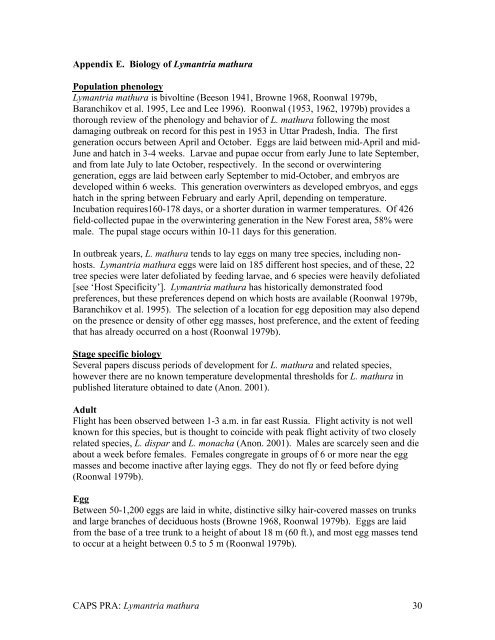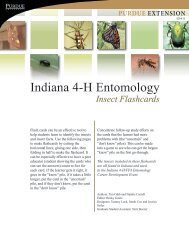Pink Gypsy Moth - aphis - US Department of Agriculture
Pink Gypsy Moth - aphis - US Department of Agriculture
Pink Gypsy Moth - aphis - US Department of Agriculture
You also want an ePaper? Increase the reach of your titles
YUMPU automatically turns print PDFs into web optimized ePapers that Google loves.
Appendix E. Biology <strong>of</strong> Lymantria mathura<br />
Population phenology<br />
Lymantria mathura is bivoltine (Beeson 1941, Browne 1968, Roonwal 1979b,<br />
Baranchikov et al. 1995, Lee and Lee 1996). Roonwal (1953, 1962, 1979b) provides a<br />
thorough review <strong>of</strong> the phenology and behavior <strong>of</strong> L. mathura following the most<br />
damaging outbreak on record for this pest in 1953 in Uttar Pradesh, India. The first<br />
generation occurs between April and October. Eggs are laid between mid-April and mid-<br />
June and hatch in 3-4 weeks. Larvae and pupae occur from early June to late September,<br />
and from late July to late October, respectively. In the second or overwintering<br />
generation, eggs are laid between early September to mid-October, and embryos are<br />
developed within 6 weeks. This generation overwinters as developed embryos, and eggs<br />
hatch in the spring between February and early April, depending on temperature.<br />
Incubation requires160-178 days, or a shorter duration in warmer temperatures. Of 426<br />
field-collected pupae in the overwintering generation in the New Forest area, 58% were<br />
male. The pupal stage occurs within 10-11 days for this generation.<br />
In outbreak years, L. mathura tends to lay eggs on many tree species, including nonhosts.<br />
Lymantria mathura eggs were laid on 185 different host species, and <strong>of</strong> these, 22<br />
tree species were later defoliated by feeding larvae, and 6 species were heavily defoliated<br />
[see ‘Host Specificity’]. Lymantria mathura has historically demonstrated food<br />
preferences, but these preferences depend on which hosts are available (Roonwal 1979b,<br />
Baranchikov et al. 1995). The selection <strong>of</strong> a location for egg deposition may also depend<br />
on the presence or density <strong>of</strong> other egg masses, host preference, and the extent <strong>of</strong> feeding<br />
that has already occurred on a host (Roonwal 1979b).<br />
Stage specific biology<br />
Several papers discuss periods <strong>of</strong> development for L. mathura and related species,<br />
however there are no known temperature developmental thresholds for L. mathura in<br />
published literature obtained to date (Anon. 2001).<br />
Adult<br />
Flight has been observed between 1-3 a.m. in far east Russia. Flight activity is not well<br />
known for this species, but is thought to coincide with peak flight activity <strong>of</strong> two closely<br />
related species, L. dispar and L. monacha (Anon. 2001). Males are scarcely seen and die<br />
about a week before females. Females congregate in groups <strong>of</strong> 6 or more near the egg<br />
masses and become inactive after laying eggs. They do not fly or feed before dying<br />
(Roonwal 1979b).<br />
Egg<br />
Between 50-1,200 eggs are laid in white, distinctive silky hair-covered masses on trunks<br />
and large branches <strong>of</strong> deciduous hosts (Browne 1968, Roonwal 1979b). Eggs are laid<br />
from the base <strong>of</strong> a tree trunk to a height <strong>of</strong> about 18 m (60 ft.), and most egg masses tend<br />
to occur at a height between 0.5 to 5 m (Roonwal 1979b).<br />
CAPS PRA: Lymantria mathura 30
















